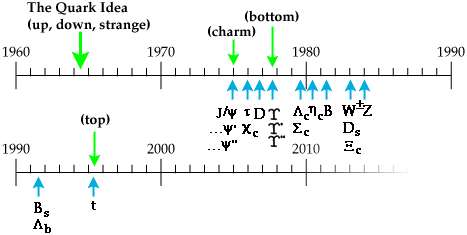
| 1964 | Murray Gell-Mann and George Zweig tentatively put forth the idea of quarks. They suggested that mesons and baryons are composites of three quarks or antiquarks, called up, down, or strange (u, d, s) with spin 0.5 and electric charges 2/3, -1/3, -1/3, respectively (it turns out that this theory is not completely accurate). Since the charges had never been observed, the introduction of quarks was treated more as a mathematical explanation of flavor patterns of particle masses than as a postulate of actual physical object. Later theoretical and experimental developments allow us to now regard the quarks as real physical objects, even though they cannot be isolated. |
| 1964 | Since leptons had a certain pattern, several papers suggested a fourth quark carrying another flavor to give a similar repeated pattern for the quarks, now seen as the generations of matter. Very few physicists took this suggestion seriously at the time. Sheldon Glashow and James Bjorken coin the term "charm" for the fourth (c) quark. |
| 1965 | O.W. Greenberg, M.Y. Han, and Yoichiro Nambu introduce the quark property of color charge. All observed hadrons are color neutral. |
| ...1966... | The quark model is accepted rather slowly because quarks hadn't been observed. |
| 1967 | Steven Weinberg and Abdus Salam separately propose a theory that unifies electromagnetic and weak interactions into the electroweak interaction. Their theory requires the existence of a neutral, weakly interacting boson (now called the Z0) that mediates a weak interaction that had not been observed at that time. They also predict an additional massive boson called the Higgs Boson that has not yet been observed. |
| 1968-69 | At the Stanford Linear Accelerator, in an experiment in which electrons are scattered off protons, the electrons appear to be bouncing off small hard cores inside the proton. James Bjorken and Richard Feynman analyze this data in terms of a model of constituent particles inside the proton (they didn't use the name "quark" for the constituents, even though this experiment provided evidence for quarks.) |
| 1970 | Sheldon Glashow, John Iliopoulos, and Luciano Maiani recognize the critical importance of a fourth type of quark in the context of the Standard Model. A fourth quark allows a theory that has flavor-changing Z0-mediated weak interactions but no flavor-changing ones. |
| 1973 | Donald Perkins, spurred by a prediction of the Standard Model, re-analyzes some old data from CERN and finds indications of weak interactions with no charge exchange (those due to a Z0 exchange.) |
| 1973 | A quantum field theory of strong interaction is formulated. This theory of quarks and gluons (now part of the Standard Model) is similar in structure to quantum electrodynamics (QED), but since strong interaction deals with color charge this theory is called quantum chromodynamics (QCD). Quarks are determined to be real particles, carrying a color charge. Gluons are massless quanta of the strong-interaction field. This strong interaction theory was first suggested by Harald Fritzsch and Murray Gell-Mann. |
| 1973 | David Politzer, David Gross, and Frank Wilczek discover that the color theory of the strong interaction has a special property, now called "asymptotic freedom." The property is necessary to describe the 1968-69 data on the substrate of the proton. |
| 1974 | In a summary talk for a conference, John Iliopoulos presents, for the first time in a single report, the view of physics now called the Standard Model. If you want to understand the various aspects of the Standard Model, please explore the Standard Model Path. |
| 1974 (Nov.) | Burton Richter and Samuel Ting, leading independent experiments, announce on the same day that they discovered the same new particle. Ting and his collaborators at Brookhaven called this particle the "J" particle, whereas Richter and his collaborators at SLAC called this particle the psi particle. Since the discoveries are given equal weight, the particle is commonly known as the J/psi particle. The J/psi particle is a charm-anticharm meson. |
| 1976 | Gerson Goldhaber and Francois Pierre find the D0 meson (anti-up and charm quarks). The theoretical predictions agreed dramatically with the experimental results, offering support for the Standard Model. |
| 1976 | The tau lepton is discovered by Martin Perl and collaborators at SLAC. Since this lepton is the first recorded particle of the third generation, it is completely unexpected. |
| 1977 | Leon Lederman and his collaborators at Fermilab discover yet another quark (and its antiquark). This quark was called the "bottom" quark. Since physicists figured that quarks came in pairs, this discovery adds impetus to search for the sixth quark -- "top." |
| 1978 | Charles Prescott and Richard Taylor observe a Z0 mediated weak interaction in the scattering of polarized electrons from deuterium which shows a violation of parity conservation, as predicted by the Standard Model, confirming the theory's prediction. |
| 1979 | Strong evidence for a gluon radiated by the initial quark or antiquark if found at PETRA, a colliding beam facility at the DESY laboratory in Hamburg, |
| 1983 | The W± and Z0 intermediate bosons demanded by the electroweak theory are observed by two experiments using the CERN synchrotron using techniques developed by Carlo Rubbia and Simon Van der Meer to collide protons and antiprotons. |
| 1989 | Experiments carried out in SLAC and CERN strongly suggest that there are three and only three generations of fundamental particles. This is inferred by showing that the Z0-boson lifetime is consistent only with the existence of exactly three very light (or massless) neutrinos. |
| 1995 | After eighteen years of searching at many accelerators, the CDF and D0 experiments at Fermilab discover the top quark at the unexpected mass of 175 GeV. No one understands why the mass is so different from the other five quarks. |